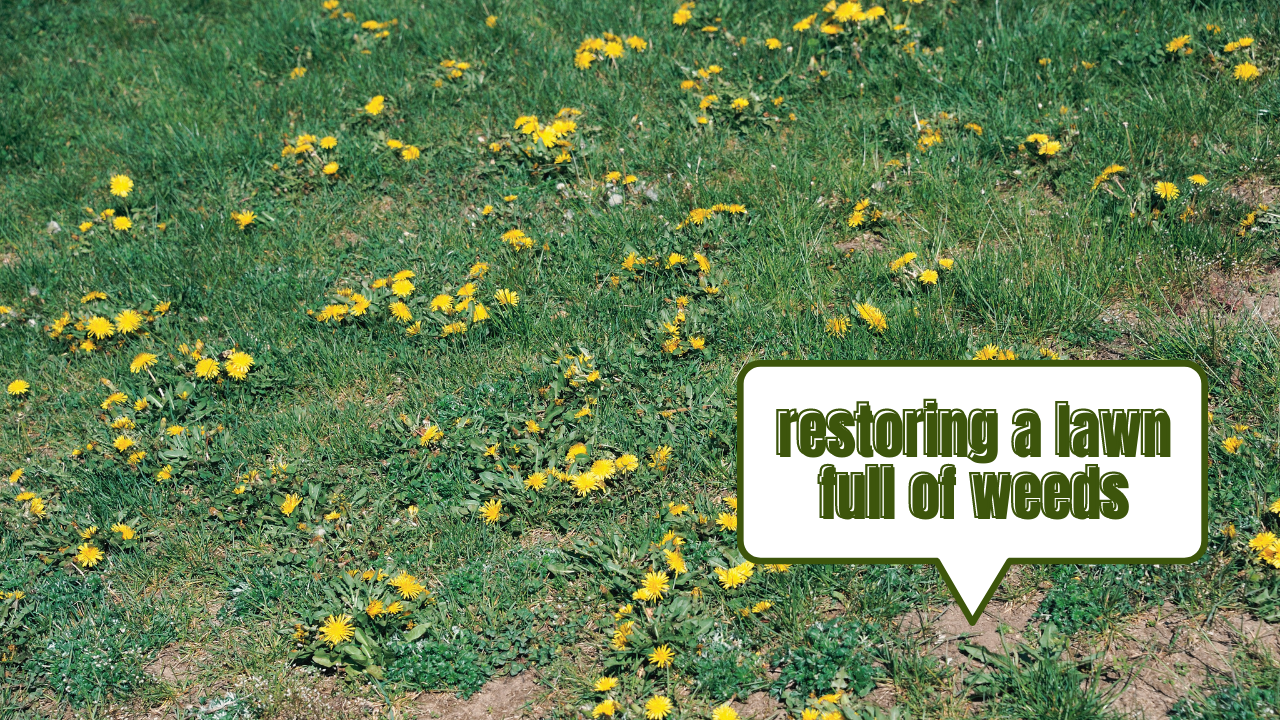Let's face it. All of us want a lush, radiant green lawn with even grass without visible stringy ivy, coarse clovers, or fuzzy dandelions.
When overlooked, these persistent weeds will only multiply until they destroy the entirety of your lawn. Fortunately, you can restore your patchy lawn (full of weeds) to its former glory. (Related: 4 Week Lawn Transformation: How did we do it?!)
Here's how to effectively get rid of weeds in the yard for good.
Pre-Treatment: Assess the Condition of the Yard
Before you proceed with fixing the yard, you will need to identify the grass and the lawn’s current condition. This will give you an idea of how severe the damage is.
Grass Density
The moment you see visible patches of dirt between the grasses, that's usually the first tell-tale sign of a yard problem. This usually starts with the insufficiently watered parts, as they do not get enough nutrients to thrive.
Thatch
This refers to a matte layer of grassroots and other dead organisms on the soil's surface. Usually, a thatch layer measuring 0.25 to 0.5 inches (0.6 – 1.3 cm) in thickness is not something to worry about. It may even protect your grass from high heat and provide adequate organic matter.
But, once this thatch layer grows beyond 0.5 inches (1.3 cm) thick, it will become a nuisance and may end up choking the grass. A thick thatch also tends to absorb all the moisture during rain, leaving your lawn with insufficient water.
Grassroots Depth
Weak grass with shallow roots will have difficulty reaching the nutrients from the soil. Remember that healthy grasses have 6 inches (15 cm) roots. Anything shorter than that will only make it susceptible to weed growth.
Weed Spread
If pesky weeds spread over 50% of the lawn, you will most likely lose the fight. As such, it's best to act on weed control procedures once you notice the first tell-tale signs. Start by determining the correct type of weed that plagues your lawn and the total area of the affected yard.
How to Fix a Yard Full of Weeds: A Step-by-Step Guide

Step 1: Identify the Weeds
To ensure successful treatment results, determine the specific weed varieties thriving in your yard. This allows you to select the appropriate weed treatment methods that are effective against these weeds.
Common lawn weeds can be divided into three categories:
Step 2: Use the Right Herbicide
Next, you will need to choose the proper weed treatment method based on its classification and growth stage.
Fortunately, some herbicides can deal with pre-emergent weeds before they even become a headache. For established weeds, you can use post-emergent commercial herbicides.
Important Note: Herbicides can kill all plant life upon application, even when the manufacturer label claims otherwise. If you want to rejuvenate your lawn, destroying the existing, thin grass shouldn't be a matter of concern as you will need to start from scratch.
Step 3: Treatment Application
When dealing with chemicals, you must follow the directions as per the manufacturer's guidelines. Ensure that the product is applied at the proper time.
If you live in an area in the country with frequent rain showers, always check the forecast ahead of time. The last thing you'd want is for the rain to wash away the herbicide and its weed control effects.
Step 4: Let it Sit Out
Depending on your chosen weed treatment type, you may need to wait for a while before you can plant new seeds. This may take up to four weeks or more.
Step 5: Rake and Till the Lawn
Once you see the weeds and the grass is visibly brown, you will need to use a rake to scrape as many weeds as possible. Get rid of any extra weeds and till the soil in preparation for the new seeding process.
Step 6: Dethatch and Aerate
The process of aerating the lawn helps break up thick thatches, which may cause root damage or potential rotting. If the layer is too thick, you may use a dethatching rake to prepare the soil accordingly.
Aeration enhances the access of the grassroots to air, nutrients, and water. You may use either a spike or a core aerator to break up the soil. In using a core aerator, ensure to do two to three passes in various directions. Let the removed soil plugs decompose atop the surface layer instead of getting rid of them.
Step 7: Amend the Soil
When all that’s said and done, apply the soil amendment to prepare your soil for your new sod or grass seed.
Step 8: Choose between Laying the Seed Down or Sod
You need to choose between laying down the seed or sod at this stage. Here are a few considerations to keep in mind:
Seed
Sod
After doing either method, ensure to till the soil down to 6 or 8 inches. You can use a broadcast spreader to spread the right amount of seeds in the area. Generally, this translates to fifteen seeds per square inch (0.00065 m2).
Step 9: Maintain Your New Lawn
After watering the new lawn, you will need to follow proper upkeep, so it won't be destroyed by weeds again. This includes adequate drying, mowing, and spreading weed-killing fertilizer.
If you want to ensure the grassroots develop correctly, use a lawn fertilizer rich in nitrogen, potassium, and phosphorus. Some states ban phosphorus in fertilizers due to water pollution issues. In that case, choose fertilizers labeled explicitly for 'New Lawns' or 'Starter.'
It's also good to use a seasonal treatment to ensure the lawn stays clear of weed activity. You may apply this once every three months.
Frequently Asked Questions
What's the best way to get rid of weeds permanently?
Weeds are plants, just like grass, flowers, and shrubs, even though we consider them nuisances. They'll become as thick and invasive as our favorite herbs if we allow them. As a result, the best way to get rid of weeds is to create an environment where they struggle to grow. Weeds thrive in low-mowed grass, compacted soil, and turf that's not getting enough water. The best way to permanently eliminate weeds is to address these issues and maintain a healthy lawn.
How can I kill pesky lawn weeds without killing my existing grass?
Herbicides, both pre-emergent and post-emergent, are designed explicitly for weeds. The most common application of pre-emergents is for crabgrass and post-emergents for dandelions. They're not going to harm your grass (if applied correctly).
Is it possible to get rid of weeds on a lawn naturally?
Yes! However, it may take more time and effort. A natural way to get rid of weeds is to spray vinegar directly on them. It eliminates what's above ground by drying out the plant leaves. Also, use vinegar with a higher acetic acid content than the average 5%. Instead of going to the supermarket, search for 10 to 20% acetic acid vinegar at a home improvement store. According to USDA research, spraying kills 80% of weeds' top growth. This method is most effective when only a few weeds spread throughout the grass. It's better to use a safe, effective herbicide for larger spreads.

